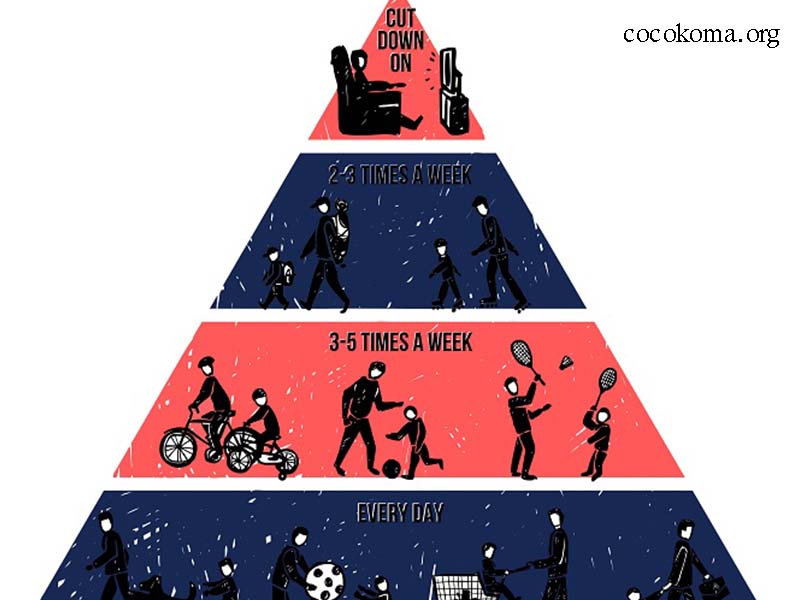Physical activity is an essential component of a healthy lifestyle, contributing significantly to overall well-being and fitness. Among the various frameworks used to categorize physical activity, the Physical Activity Pyramid serves as a valuable guide. It illustrates the different levels of physical activity and emphasizes the importance of incorporating a variety of activities into our daily lives. Within this pyramid, lifestyle activities occupy a critical space, representing the foundation of a physically active life. In this article, we will explore where lifestyle activities fit into the Physical Activity Pyramid, their significance, and how they contribute to a healthier lifestyle.
What is the Physical Activity Pyramid?
The Physical Activity Pyramid is a visual representation that categorizes physical activities into different levels, illustrating their importance in achieving a well-rounded fitness regimen. The pyramid is divided into several sections, each representing different types of activities, from more vigorous exercise at the top to more basic, everyday activities at the bottom.
- Sedentary Activities: At the base of the pyramid are sedentary activities, which include sitting and inactivity. This level serves as a reminder of what to minimize in our daily routines.
- Lifestyle Activities: Above the sedentary level, lifestyle activities are the foundation of the pyramid. These activities encompass everyday movements that can be integrated into our routines, promoting physical activity without the need for structured exercise sessions.
- Aerobic Activities: Moving up the pyramid, aerobic activities involve more structured forms of exercise such as walking, running, cycling, or swimming, which increase heart rate and improve cardiovascular fitness.
- Flexibility Activities: Further up the pyramid are flexibility activities, which include stretching and yoga. These exercises enhance the body’s range of motion and help prevent injuries.
- Strength Activities: At the top of the pyramid are strength training activities, which focus on building muscle strength and endurance through weightlifting or resistance exercises.
Lifestyle Activities: The Foundation of the Pyramid
Lifestyle activities are crucial for maintaining an active lifestyle, making up the base of the Physical Activity Pyramid. They include any movement that occurs throughout the day as part of routine tasks. These activities are often low to moderate in intensity but can significantly impact overall health when performed consistently. Examples include:
- Walking: Whether commuting to work, strolling through the neighborhood, or walking the dog, this simple activity is an easy way to increase daily physical activity.
- Household Chores: Activities like cleaning, gardening, or doing laundry involve movement that contributes to energy expenditure and can improve overall fitness.
- Active Transportation: Biking or walking to school or work instead of driving promotes cardiovascular health and reduces sedentary time.
- Recreational Activities: Engaging in hobbies such as dancing, playing with children, or even playing casual sports like basketball or soccer are all lifestyle activities that enhance physical well-being.
Why are Lifestyle Activities Important?
Incorporating lifestyle activities into daily routines is vital for several reasons:
- Accessibility: Lifestyle activities are accessible to most people, regardless of fitness level. They do not require special equipment or memberships, making it easier to engage in regular movement.
- Sustainability: These activities can be sustained over the long term, fostering a consistent habit of physical activity. They are often enjoyable and can be done in social settings, enhancing motivation.
- Health Benefits: Engaging in lifestyle activities contributes to various health benefits, including improved cardiovascular health, weight management, reduced risk of chronic diseases, and enhanced mental well-being.
- Reduced Sedentary Time: Incorporating movement into daily life helps counteract the negative effects of prolonged sitting, which has been linked to various health issues.
- Enhanced Quality of Life: By being more active throughout the day, individuals often report higher energy levels, better mood, and improved overall quality of life.
How to Incorporate More Lifestyle Activities
Increasing lifestyle activities doesn’t require drastic changes. Here are some practical strategies to integrate more movement into daily routines:
- Take the Stairs: Opt for stairs instead of elevators or escalators whenever possible. Climbing stairs is an effective way to increase heart rate and strengthen leg muscles.
- Walk or Bike for Short Trips: For nearby errands, consider walking or biking instead of driving. Not only does this contribute to physical activity, but it also reduces carbon emissions.
- Schedule Active Breaks: If you have a desk job, schedule short breaks every hour to stand, stretch, or walk around the office. These small breaks can refresh your mind and body.
- Engage in Household Activities: Turn chores into a workout by increasing your pace or incorporating movement. Dancing while cleaning or doing yard work can make these tasks more enjoyable.
- Participate in Community Events: Look for local events that encourage physical activity, such as community walks, charity runs, or fitness classes. These events can be social and motivating.
- Involve Family and Friends: Encourage loved ones to join you in lifestyle activities, making it a fun and supportive experience. Play games or sports together, or simply go for walks as a group.
Lifestyle Activities vs. Structured Exercise
While lifestyle activities are essential, it’s important to recognize their distinction from structured exercise. Structured exercise is often more intense, planned, and performed for a specific duration. Both types of activities have their benefits:
- Structured Exercise: Offers cardiovascular benefits, muscle strengthening, and flexibility improvements. It often follows a routine or program designed for fitness goals.
- Lifestyle Activities: Focus on incorporating movement into daily routines. While they may not offer the same intensity as structured exercise, they provide a foundation for a physically active life.
For optimal health, individuals should aim to include both lifestyle activities and structured exercise in their routines. The combination ensures a well-rounded approach to fitness, enhancing overall health and well-being.
The Impact of Lifestyle Activities on Health Outcomes
Research consistently shows that engaging in lifestyle activities can lead to significant health improvements. Studies indicate that individuals who incorporate more movement into their daily lives tend to have lower rates of obesity, heart disease, diabetes, and certain types of cancer. Furthermore, these activities have been linked to better mental health outcomes, including reduced anxiety and depression.
- Weight Management: Regular lifestyle activities contribute to energy expenditure, making it easier to maintain a healthy weight. The cumulative effect of daily movement can lead to weight loss or maintenance over time.
- Cardiovascular Health: Engaging in activities that elevate heart rate, even at a low intensity, can improve cardiovascular health. Regular movement helps lower blood pressure, improve cholesterol levels, and reduce the risk of heart disease.
- Mental Well-Being: Physical activity releases endorphins, which can enhance mood and reduce feelings of stress and anxiety. Lifestyle activities often involve social interaction, further boosting mental well-being.
- Longevity: Studies suggest that individuals who are more physically active throughout their lives tend to live longer and healthier lives. Even small increases in daily activity can contribute to significant health benefits.
Conclusion
In conclusion, lifestyle activities occupy a fundamental place in the Physical Activity Pyramid, serving as the bedrock of a healthy, active life. By incorporating everyday movements into our routines, we can enhance our physical health, mental well-being, and overall quality of life. These activities are accessible, sustainable, and crucial for reducing sedentary behavior and promoting a physically active lifestyle.
As we strive to improve our health, it’s important to remember that every movement counts. Whether it’s taking the stairs, walking to work, or dancing while doing household chores, lifestyle activities provide a simple yet effective way to incorporate physical activity into our daily lives. By embracing these activities, we can create a healthier future for ourselves and our communities, building a strong foundation for a lifetime of physical activity.








